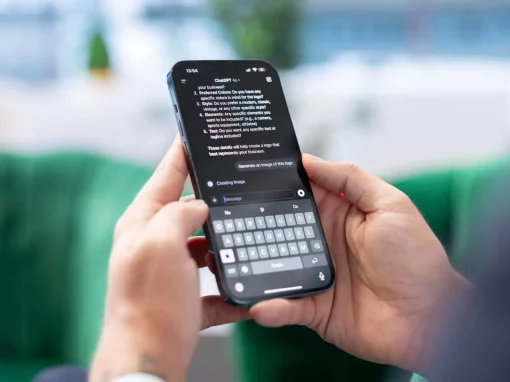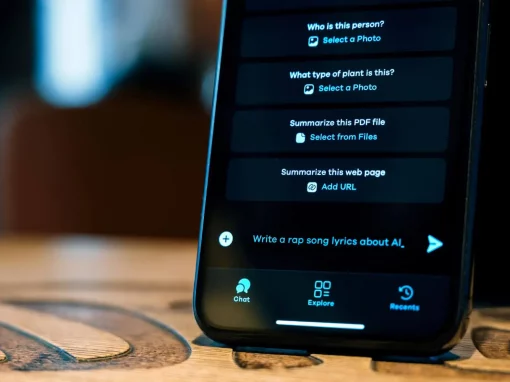Table of Contents
Listen to article
The Internet of Things (IoT) in healthcare refers to a network of connected medical devices, sensors, and software applications that collect and exchange data over the internet. In simple terms, IoT technology in healthcare enables everyday medical devices – from heart monitors to fitness wearables – to “talk” to each other and to healthcare IT systems in real time.
This connectivity is reshaping modern healthcare globally, allowing doctors to monitor patients’ health remotely 24/7 through connected wearables and sensors. Instead of periodic check-ups, physicians can now receive continuous streams of data on vital signs like blood pressure, heart rate, or glucose levels.
This shift is transforming care from a reactive approach (treating issues after they arise) to a proactive one, where potential health issues can be detected and addressed earlier than ever.
Globally, IoT-powered healthcare solutions are on the rise. For example, projections suggest that more than 60 million people in the United States will have used some form of remote patient monitoring (RPM) by 2024 – a testament to the scale and potential of this technology.
Doctors and hospitals worldwide are embracing IoT to improve patient outcomes, streamline operations, and personalize medicine. From smart medication dispensers that remind patients to take pills, to connected inhalers that track asthma patients’ usage, IoT is making healthcare more data-driven and patient-centric than ever.
Singapore, with its high-tech infrastructure and Smart Nation vision, is at the forefront of this IoT healthcare revolution in Asia. Often dubbed one of the world’s most technologically advanced city-states, Singapore is leveraging IoT to tackle its unique healthcare challenges.
In the sections below, we’ll explore why Singapore is embracing IoT in healthcare, the key applications emerging in its health sector, the benefits being realized, and the challenges that come with this digital transformation. We’ll also look at future trends – including how AI and IoT together are paving the way for smarter healthcare – and discuss how businesses can ride this wave (with a little help from experts like Scopic).
Why Singapore is Embracing IoT in Healthcare
Singapore’s push toward IoT in healthcare is driven by both necessity and opportunity. On the necessity side, Singapore faces an aging population and rising chronic disease burden. The number of elderly citizens (aged 65 and above) is projected to reach 900,000 by 2030 in Singapore – nearly one in four residents. This “silver tsunami,” combined with low birth rates, means a heavier healthcare burden and higher demand for medical services in the coming years.
IoT offers a way to proactively manage this demographic shift. By equipping seniors with health monitoring devices and creating smart home environments, healthcare providers can keep an eye on at-risk individuals remotely, reducing the need for frequent clinic visits or hospitalizations. As Singapore’s official Smart Nation site notes, embracing technology is critical “to better help our seniors” and meet future healthcare needs.
On the opportunity side, Singapore’s government has been a strong proponent of healthcare innovation through its Smart Nation initiative. Launched in 2014, Smart Nation is a nationwide effort to harness digital technologies – including IoT – to improve citizens’ lives. In healthcare, this has translated into policy support, funding, and regulatory frameworks that encourage experimentation with new tech.
For instance, the Ministry of Health (MOH) has set up a Health Innovation Fund of about S$200 million over five years to support ground-up development and test-bedding of innovations in public healthcare. Many of these innovations involve IoT and AI, such as remote monitoring tools and intelligent systems to aid clinicians.
Regulatory support is also evident. Singapore updated its healthcare regulations with the Healthcare Services Act, which now explicitly covers services like telemedicine and remote monitoring. As of 2022, doctor-led teleconsultations are licensed under this Act, showing the government’s willingness to adapt rules to new IoT-enabled models of care.
Moreover, in December 2023, the MOH announced a new Health Information Bill to be introduced in 2024 – the country’s first comprehensive health data law – aimed at ensuring data security and patient privacy in an increasingly digital healthcare sector. This legal framework will provide clearer guidelines for IoT deployments, addressing data protection and cybersecurity, which are crucial for building public trust in smart healthcare solutions.
Another factor driving IoT adoption is Singapore’s vision of a less hospital-centric, more community-based healthcare system. Facing land constraints and a limited healthcare workforce, Singapore is rebalancing care delivery towards the community. The government envisions more home-based care and telehealth services so that patients don’t always have to travel to hospitals for routine care. IoT is a key enabler in this shift – from telecare devices that allow elderly patients to safely age in place, to connected health kiosks in the community.
All these initiatives align with Singapore’s Smart Nation ethos of using tech to improve quality of life while keeping healthcare efficient and sustainable.
Key IoT Applications in Singapore’s Healthcare Sector
IoT is not just a buzzword in Singapore’s healthcare industry – it’s being applied in tangible, impactful ways. Let’s look at some key IoT-driven applications already making waves in Singapore’s healthcare sector:
Remote Patient Monitoring and Wearable Health Devices
One of the most prominent IoT applications is Remote Patient Monitoring (RPM) using connected health devices. RPM involves using wearables and home-use medical devices that collect patient data and send it to healthcare providers in real time.
In Singapore, this has been a game-changer for managing chronic diseases and post-discharge care. Patients can use devices like smart blood pressure monitors, glucose monitors, pulse oximeters, or fitness wearables to track their vitals daily. These devices automatically transmit data to hospital systems or cloud platforms, where doctors and care teams can review the readings.
Consider a real-world example: Changi General Hospital (CGH) in Singapore piloted a heart failure telehealth program in partnership with Philips. Launched in 2014, this program provided 150 heart failure patients with a weight scale and blood pressure monitor, plus a tablet app to upload their daily readings to a central system.
Nurse care coordinators remotely monitored these vitals and intervened when signs of deterioration appeared. The results were impressive – over the pilot, hospital readmission days dropped by 67% and care costs per patient fell by 42%. Such outcomes highlight how IoT-powered RPM can keep patients stable at home and prevent costly hospitalizations.
Many Singaporeans today also use consumer-grade wearables – think Fitbit, Apple Watches, Garmin fitness bands – that monitor activity levels, heart rate, sleep patterns, and more. While these started as lifestyle gadgets, they are increasingly part of the healthcare picture. For instance, during medical check-ups, it’s not uncommon for patients to share data from their smartwatch with their doctor, providing a more continuous health record than one-off measurements.
Hospitals and insurers are also exploring programs to integrate wearable data for wellness and chronic disease management. The continuous stream of data from these wearables allows for early alerts; if a patient’s heart rate or blood pressure trends abnormally, an alert can be sent for a follow-up, enabling early intervention before a minor issue becomes a medical emergency.
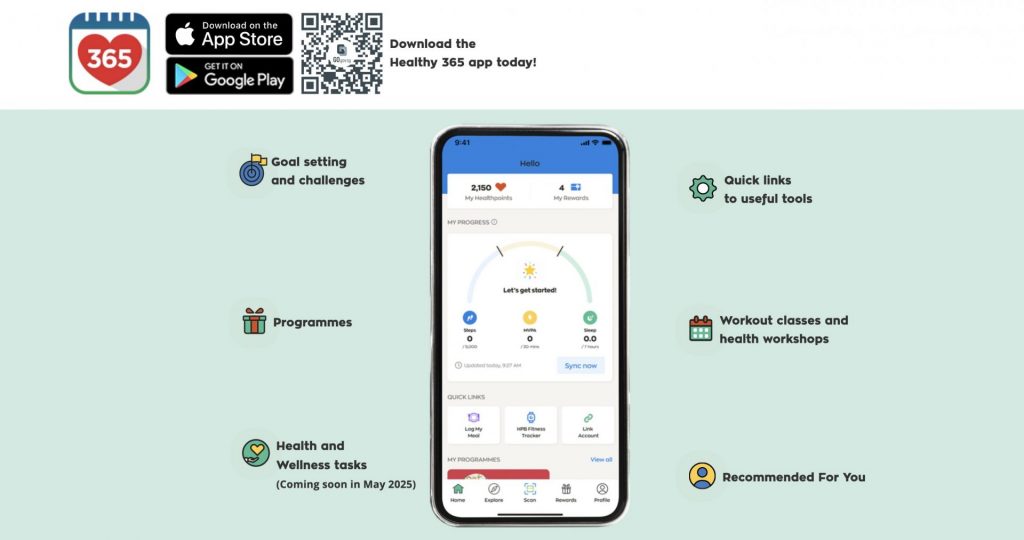
Photo Credit: HealthHub Singapore
Did You Know?
In 2019, Fitbit partnered with the Singapore government to offer free fitness trackers to 5.6 million people! Through the Healthy 365 app, Singaporeans and Permanent Residents can collect a free HPB fitness tracker from vending machines located across the island.
The Singapore Health Promotion Board also organizes the annual National Steps Challenge, where participants can earn points for completing 10,000 steps per day and redeem shopping vouchers or shop for items from the Merchant list.
Local health-tech innovators are active in this space too. Biofourmis, a Singapore-founded startup, has developed an AI-driven RPM platform using a wearable biosensor that tracks vital signs continuously. Their Everion® wearable collects data on heart rate, respiratory rate, temperature, and more, feeding it into algorithms that can predict health deteriorations and alert clinicians in advance.
In the year 2021, the FDA gave breakthrough status to Biofourmis’ heart failure DTx. This kind of predictive remote monitoring was invaluable during the COVID-19 pandemic when hospital visits were limited – it allowed doctors to manage patients from afar and only call them in when absolutely necessary, reducing infection risk. In fact, remote patient monitoring globally grew exponentially during COVID-19, and rather than reverting fully back to in-person, many healthcare providers have continued or expanded RPM programs as part of routine care.
Smart Hospitals and IoT-Enabled Medical Facilities
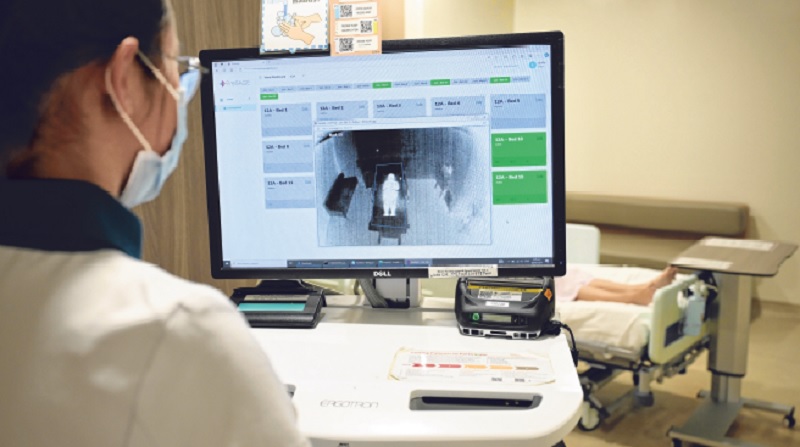
Photo Credit: Tan Tock Seng Hospital
IoT isn’t only about at-home gadgets – it’s also revolutionizing hospitals by making them “smart.” Singapore’s hospitals are increasingly adopting IoT automation solutions to enhance operational efficiency, patient safety, and overall care quality. A smart hospital uses connected devices and sensors throughout its facilities to gather data in real time and automate processes.
Tan Tock Seng Hospital (TTSH) in Singapore has been at the forefront of integrating advanced technologies to enhance patient care and safety. One notable initiative is the development of an automated, privacy-preserved fall detection and surveillance system utilizing thermal imaging smart video analytics. Traditional optical methods for fall detection, while effective, often raise privacy concerns. Alternative systems like bed-sensor pads and motion detectors have shown limitations in accuracy.
To address these challenges, TTSH developed a Fall Detection System using thermal sensing. This system captures and records patient movements through thermal imaging, allowing the identification of a patient’s position without compromising privacy. A basic visualization software represents the patient’s status through different colors. Approximately 12 units have been deployed in TTSH, with plans to implement the system in other hospitals in Singapore and Thailand.
In addition to thermal imaging, TTSH has embraced artificial intelligence (AI) to further enhance patient safety. The hospital introduced the PreSAGE system, designed to predict when a patient might leave their bed. This AI-driven system uses thermography and video analysis to monitor patients.
Sensors attached to the wall above the patient’s bed detect movements, and when a patient leaves the bed, the system triggers an alarm outside their room, accompanied by a flashing blue light. Nurses can then respond promptly, typically within one minute. The system also deactivates the alarm automatically when it detects the presence of a caregiver, allowing staff to focus entirely on the patient’s needs.
One practical example is asset tracking using IoT. Hospitals have hundreds of movable assets like wheelchairs, IV pumps, beds, and diagnostic equipment. Keeping track of these can be a logistical headache. Khoo Teck Puat Hospital (KTPH) in Singapore tackled this by deploying an IoT-based wheelchair tracking system.
In 2021, KTPH outfitted 150 wheelchairs with wireless RFID beacon tags that send location data to a hospital network. Staff can now easily locate where wheelchairs are parked via a mobile app dashboard, and they get alerts when wheelchair supply in a certain area is running low.
This ensures patients always have a wheelchair when needed and saves staff from manual searches, boosting productivity. The system even notifies when a wheelchair is due for maintenance, enhancing safety. This project, supported by Singapore’s A*STAR research agency and a local startup (IOT Workz), showcases how IoT implementation can streamline hospital operations in very tangible ways.
Beyond tracking equipment, IoT in hospitals extends to environmental monitoring and automation. Sensors can continuously monitor temperature and humidity in drug storage rooms or sensitive labs, triggering alerts if conditions go out of range. Radio-frequency identification (RFID) cabinets automatically keep inventory of high-value supplies or medications, ensuring that critical items are always stocked and traceable.
Importantly, IoT technology in healthcare also improves patient experience and safety. In newer facilities like the upcoming Woodlands Health Campus (WHC), patients will wear electronic wristbands that monitor their vitals continuously while in the hospital and even after discharge.
These wearables will track things like heart rate, activity, and sleep, and nurses can monitor patients’ status remotely on dashboards. If a patient’s vitals cross a danger threshold, an alert is generated immediately. WHC is set to be a pioneer in such tech adoption – with plans for AI analysis of data and extensive use of automation – to cope with a large 1,800-bed capacity and a projected shortage of healthcare workers.
Even in existing hospitals, we see steps toward this vision: some wards have implemented patient monitoring systems that can detect falls or unusual bed exits using pressure sensors or computer vision, alerting staff in real time to respond.
AI-Powered Predictive Healthcare with IoT Data
Another exciting application of IoT in healthcare is when it’s combined with Artificial Intelligence (AI) to enable predictive and preventative care. IoT devices generate a deluge of health data – far more than humans can easily interpret on their own.
That’s where AI algorithms (including machine learning) come in: they can analyze the continuous data from IoT sensors to detect patterns or anomalies that might indicate a budding health issue. In Singapore, where healthcare providers aim to shift from treating illness to preventing it, this fusion of IoT, AI, and ML is particularly powerful.
Imagine a scenario with an elderly patient using multiple IoT monitors at home – a blood pressure cuff, a glucometer, a fitness tracker for activity, maybe a sleep tracker. Individually, each device provides useful information. But when combined and analyzed over time, these data streams can paint a comprehensive picture of the patient’s health trajectory.
AI can correlate subtle changes – maybe a slight rise in resting heart rate coupled with reduced daily steps and poor sleep – to flag that the patient may be at risk of a heart failure exacerbation or an oncoming infection. This alert allows a doctor to intervene early (perhaps adjusting medication or scheduling a check-up) before the patient lands in the ER. Such predictive care can significantly improve outcomes and reduce hospital admissions.
Singapore’s healthcare system has been exploring these possibilities. Local startup Biofourmis, mentioned earlier, exemplifies AI-driven predictive analytics. Their platform doesn’t just collect data from a wearable; it uses built-in AI to learn a patient’s baseline and detect deviations that precede deterioration.
In one use case, Biofourmis’ AI was able to predict heart failure patients’ hospital readmissions days in advance by analyzing subtle vital sign changes, prompting timely treatment adjustments. Another global company active in Singapore is IBM – its Watson Health division has trialed cognitive computing to assist in analyzing IoT data from patients. For instance, IBM’s AI can help make sense of continuous heart rate or blood pressure streams that would otherwise overwhelm human clinicians. The AI looks for trends and out-of-range values, summarizing insights for doctors so they can make effective decisions quickly.
It’s important to note that the goal of these AI systems is not to replace doctors, but to augment their expertise – scaling their ability to monitor many patients and catch issues that manual observation might miss.
We’re also seeing predictive IoT solutions in specialized fields. In diabetes care, for example, continuous glucose monitors (CGMs) like the Abbott FreeStyle Libre or Dexcom sensor worn on the body can feed glucose readings every few minutes to a smartphone. AI can analyze this to predict dangerous lows or highs before they happen, and some systems even automate insulin dosing (the beginnings of an “artificial pancreas”). In Singapore, where diabetes is a key health concern, such IoT+AI solutions are being adopted in specialist clinics.
Another area is predictive maintenance of medical equipment: IoT sensors on machines like MRI scanners or ventilators can alert technicians when a part is wearing out before a breakdown occurs, thus avoiding downtime that could impact patient care.
Crucially, the Singapore government’s focus on preventive care is driving more interest in these AI-powered models. MOH’s recent strategy highlights developing predictive preventive care, using tech to keep people healthy rather than just treating them when sick.
This includes analyzing population health data to identify at-risk groups and intervening early – an approach supercharged by IoT data from wearables and health apps. When aggregated (with proper privacy safeguards), data from thousands of devices can help public health officials spot trends – for example, noticing if seniors in a certain district show reduced activity levels, which might indicate isolation or emerging mobility issues that can be addressed through community programs.
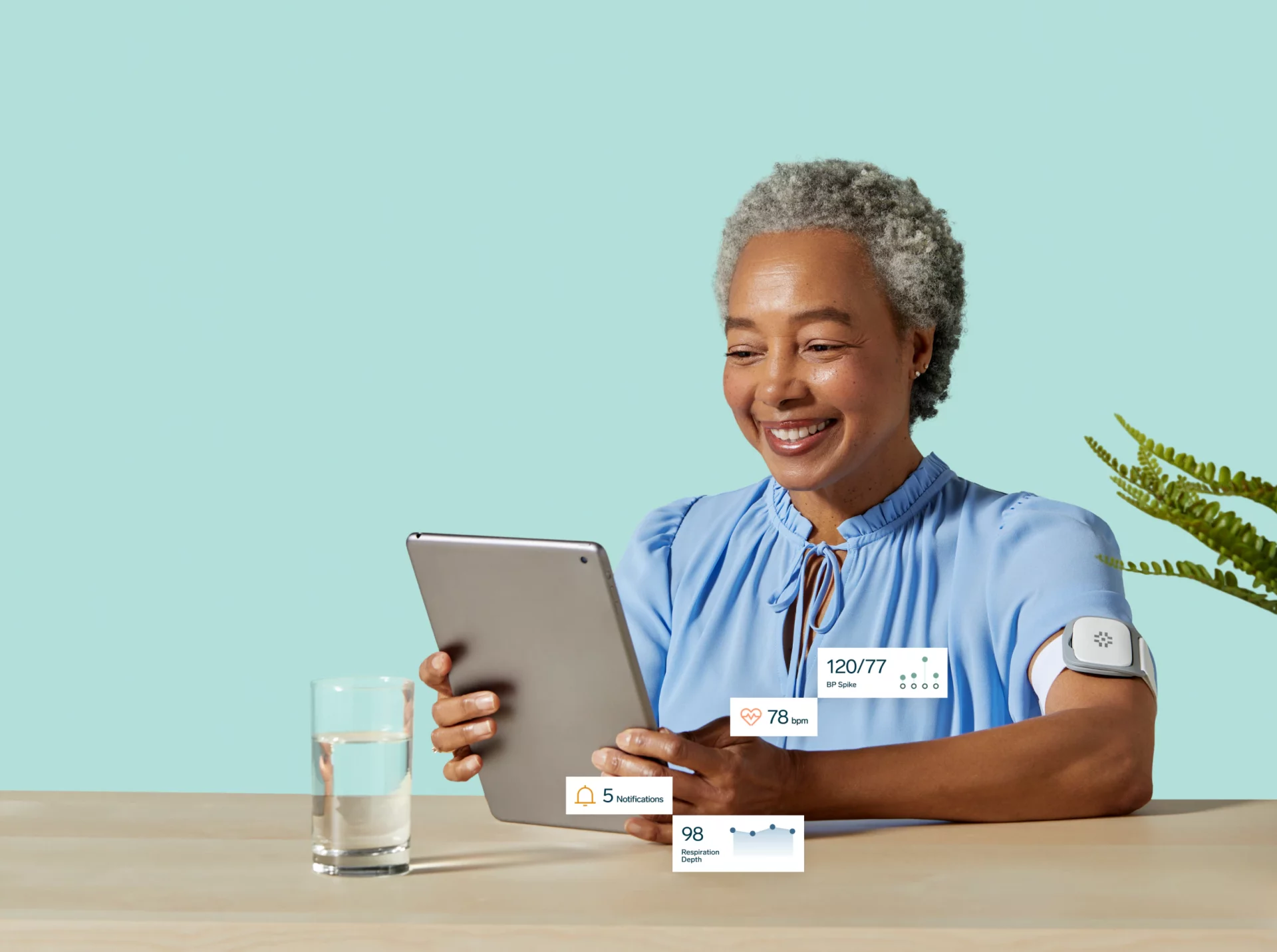
Photo Credit: Biofourmis
Telemedicine and IoT-Driven Home Healthcare Solutions
Telemedicine – the remote delivery of clinical services via telecommunications – has boomed in Singapore, especially in recent years. While video consultations and health apps are one side of telemedicine, IoT provides the essential other half: remote clinical-grade monitoring and treatment in the home setting. By integrating IoT devices with telehealth platforms, doctors can virtually examine patients with a near in-person level of data.
In a telemedicine scenario enhanced by IoT, a patient at home can connect to a doctor through a secure video call and share live readings from IoT devices. For example, during a tele-consult, a diabetic patient could use a connected glucometer and instantly show the doctor their blood sugar reading on-screen, or even grant the clinic access to a week’s worth of blood sugar data stored in the cloud.
A patient with hypertension might wear a smart blood pressure cuff that transmits real-time readings to the doctor during the call. Some telehealth kits include digital stethoscopes, otoscopes (for ear exams), or ultrasound probes that a patient or caregiver at home can use while the doctor listens/sees the feed remotely. These IoT-enabled tools make telemedicine far more effective than a basic video chat, approaching the quality of an actual physical exam from afar.
Singapore’s healthcare providers have been quick to adopt telemedicine, with many public and private players offering services. The government’s regulatory sandbox in past years allowed telemedicine startups to trial services, and now we have established providers like Doctor Anywhere, MyDoc, and WhiteCoat operating in Singapore.
During the COVID-19 pandemic, telemedicine became a critical tool to deliver care while people stayed at home, and IoT devices were enlisted to monitor conditions like COVID patients’ oxygen levels remotely. Patients who were isolating at home with COVID were given pulse oximeters to track blood oxygen and report readings to virtual care teams, enabling early intervention if readings deteriorated.
IoT-driven home healthcare is also improving elderly care and rehabilitation in Singapore. For instance, fall detection sensors and panic buttons have been introduced in some seniors’ homes. In one pilot, Bluetooth-enabled call buttons were given to at-risk seniors living alone – if they fell or faced an emergency, they could press the button to alert responders. Similarly, motion sensors can detect lack of movement (potentially indicating a fall or unconsciousness) and automatically send an alert.
These systems extend the reach of healthcare to homebound individuals and provide peace of mind to caregivers. Singapore’s HDB smart flat initiatives have also looked at incorporating such IoT sensors in public housing for seniors. Telehealth programs for chronic disease management often dispatch IoT kits to patients – as in the CGH example earlier – so that while patients connect with a tele-nurse by phone, their devices are uploading data behind the scenes. This blend of human touch and tech data is key to effective remote care.
Another aspect is home automation for healthcare – sometimes dubbed “Ambient Assisted Living.” Simple IoT devices like smart pill dispensers ensure patients take medications on time (and notify a nurse or family member if doses are missed). Smart home speakers or tablets can serve as always-on companions that remind patients of appointments or allow them to ask health questions via voice.
Singapore’s start-ups are active here too: some IoT development companies are developing home monitoring systems for dementia patients that use door sensors (to prevent wandering) and trackers to monitor daily activity and send alerts if something seems off (e.g., not opening the fridge all day might indicate the person hasn’t eaten). These may integrate with telehealth services where a nurse can follow up.
Telemedicine combined with IoT truly enables “hospital at home” models. Patients can be discharged earlier with IoT devices continuing to watch over them, and doctors doing virtual rounds. It’s telling that Singapore’s new healthcare facilities like Woodlands Health Campus plan to monitor patients even after they leave the hospital, via wearable trackers and telehealth follow-ups. This ensures continuity of care from hospital to home, reducing the chances of relapse.
For patients, the benefits are immense: convenience (no need to travel or wait in clinics), timely care (a doctor is a click away), and comfort of being at home. For the healthcare system, telehealth with IoT alleviates clinic congestion and allows one clinician to manage many distributed patients efficiently.
It’s also more resilient in times of crisis – as seen during the pandemic. As connectivity (like 5G networks) improves and devices become more user-friendly, we can expect telemedicine in Singapore to incorporate even more IoT elements. Imagine remote maternity care with fetal heart rate monitors at home, or dermatology consults with high-res camera attachments, all possible with IoT tools.
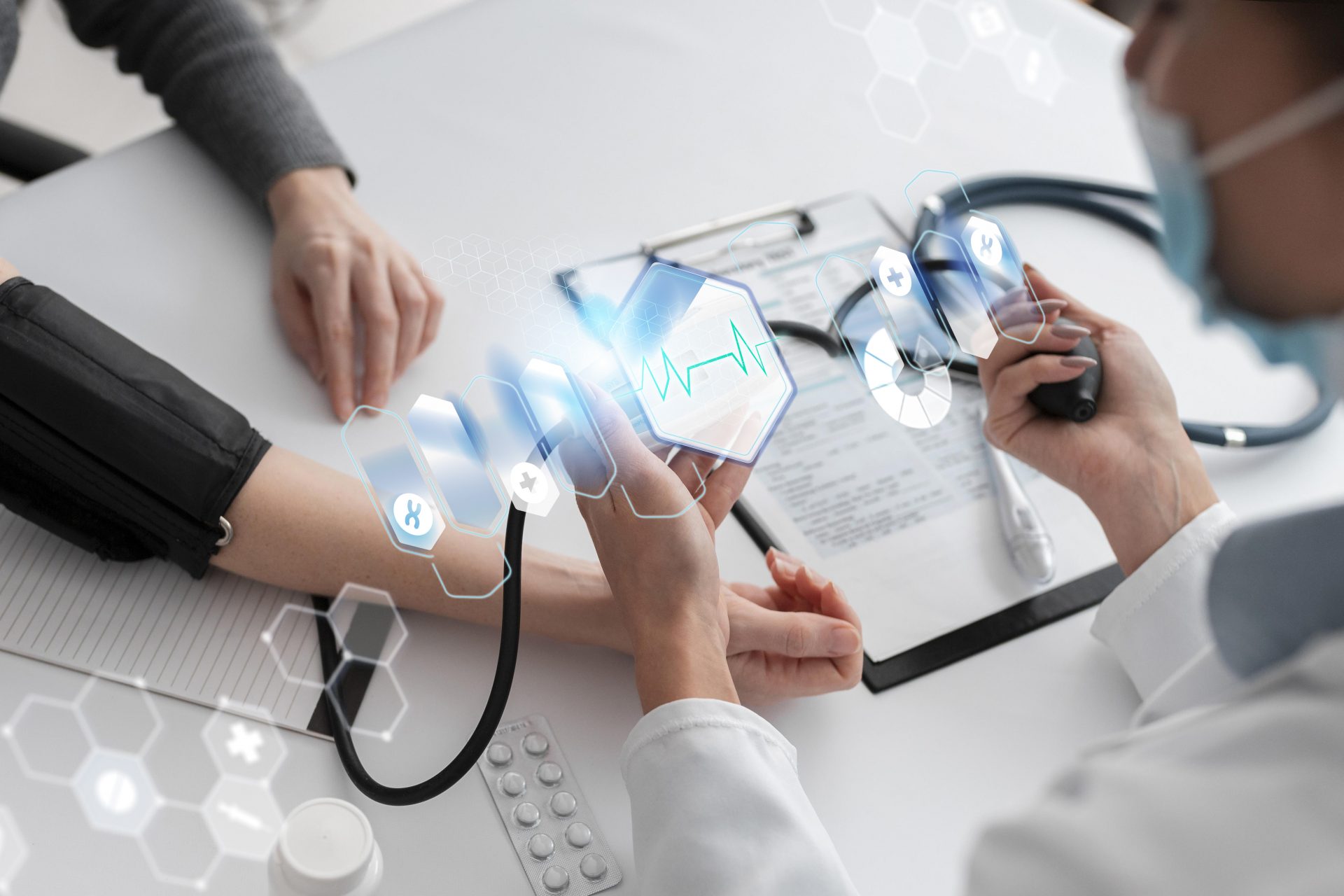
Challenges and Considerations
While the advantages of IoT technology in healthcare are compelling, it’s not without challenges. Both globally and in Singapore, stakeholders must navigate several considerations and hurdles to fully realize IoT’s potential in healthcare:
1. Data Privacy and Security
Perhaps the most critical concern is keeping sensitive health data safe. IoT devices dramatically increase the points of data generation and transmission – each sensor or wearable could be a target for hackers if not properly secured. Data privacy is paramount because healthcare data is highly personal.
One industry association in Singapore noted that security and privacy are among the most significant challenges IoT poses in healthcare. There are real risks: cybercriminals could potentially intercept medical device data, steal personal health information, or even hijack a device (imagine an insulin pump being maliciously controlled).
In 2018, Singapore experienced a major healthcare data breach (not IoT-related, but a wake-up call) which underscored that bad actors are interested in medical data. To address this, Singapore is stepping up regulatory safeguards – as mentioned, the upcoming Health Information Bill will enforce robust cybersecurity and data protection standards for all healthcare providers.
All IoT solutions must comply with privacy laws like PDPA (Personal Data Protection Act) and healthcare-specific guidelines. Strong encryption, authentication, and secure networks are a must for any IoT deployment. Building patient trust is crucial – people need to be confident that wearing a health sensor or sharing device data will not expose them to privacy invasions. In short, data security isn’t optional; it’s foundational for IoT in healthcare.
2. Availability of Medical Data for AI and Machine Learning
When Scopic asked a Chief Data Scientist of a notable university’s healthcare department about his biggest challenge, he mentioned that the availability of data is a major hurdle. Machine learning models require large datasets to train and improve accuracy.
However, medical data is often scarce, fragmented, or difficult to access due to privacy regulations and interoperability issues. This lack of high-quality, readily available datasets can limit the effectiveness of AI-driven IoT healthcare solutions.
In Singapore, while efforts are being made to integrate electronic health records across institutions, there is still a need for more standardized data-sharing frameworks that allow AI models to continuously learn and improve patient care predictions without compromising privacy.
3. Interoperability and Integration with Legacy Systems
Healthcare IT ecosystems are complex, often consisting of older legacy systems (like hospital record systems) alongside newer digital tools. Integrating a fleet of new IoT devices into these existing systems can be challenging. Many legacy electronic health record (EHR) platforms were not designed to handle streaming data from wearables or to interface with cloud IoT platforms.
As a result, interoperability issues arise – devices might use different data formats or communication protocols that don’t “speak” to the hospital’s software. Without integration, the IoT data lives in silos, limiting its usefulness.
A commentary on healthcare IoT adoption noted that integrating IoT devices into existing infrastructure is one of the primary obstacles, as many hospitals operate on outdated IT systems not equipped for modern IoT’s real-time, data-intensive needs. Overcoming this may require upgrading IT infrastructure or using middleware that can translate and funnel IoT data into legacy systems.
Singapore’s healthcare sector has been pushing for standards (like HL7 FHIR for data exchange) and building the National Electronic Health Record (NEHR) which could serve as a centralized repository to aggregate data from various sources. Still, healthcare providers must plan carefully to ensure any new IoT solution can interface smoothly with their current workflows and software. Vendor lock-in is another risk – if each IoT device comes with its own proprietary system, it becomes costly to manage multiple platforms. Emphasizing open standards and interoperability from the get-go is key.
4. Infrastructure and Scalability
IoT in healthcare relies on robust infrastructure – not just within a facility but also city-wide connectivity. The devices are only as useful as the networks they communicate over. Singapore fortunately has excellent broadband and 4G/5G coverage, but healthcare providers still need to ensure Wi-Fi dead zones in a hospital don’t cause device dropouts or that there’s backup connectivity for critical devices (like fall sensors that should never fail).
Cloud servers and data pipelines must be able to handle the massive data influx from potentially thousands of devices streaming simultaneously. Scalability is a challenge: a pilot with 50 patients might work great, but what about 5,000 patients across multiple hospitals? Planning for scale, data storage, and processing power (perhaps leveraging Singapore’s government cloud or reliable cloud providers) is essential.
Also, device management at scale – updating firmware, replacing batteries, and ensuring devices are functioning – becomes a logistical issue. If not managed well, devices can go offline without notice. Healthcare institutions will need proper IoT device management platforms and possibly partnerships with tech companies to keep the device fleet healthy.
5. Ethical and Data Governance Considerations
With so much data being collected, questions arise about who owns the data, how it can be used, and ensuring it’s used ethically. Singapore is quite forward-thinking on governance – initiatives are in place to govern AI in healthcare, for example – but similar attention is needed for IoT data usage.
If, say, an insurer wants to use data from a patient’s fitness tracker to determine premiums, is that acceptable? How do we prevent potential discrimination or misuse of health IoT data? These are largely policy and ethical questions beyond technology but are important for maintaining public trust in IoT healthcare programs. Ensuring transparency (patients should know what data is collected and for what purpose) and consent will be key principles.
Future Trends and Opportunities
The intersection of IoT and healthcare in Singapore is an evolving story, and the coming years promise even more exciting developments. Here are some future trends and opportunities to watch as IoT continues to transform healthcare:
1. Advancements in AI-Driven IoT Healthcare Solutions
The marriage of IoT with Artificial Intelligence will deepen. We can expect more predictive analytics and even prescriptive analytics (where the system not only predicts an issue but also suggests interventions).
Singapore’s research institutions and startups are likely to develop AI models tailored to local population health trends, making IoT data interpretation smarter. For example, AI might help predict outbreaks of dengue or influenza by analyzing data from wearable thermometers and other community health sensors in real time.
Machine learning at the edge is another emerging trend – instead of sending all data to the cloud, some processing will happen on the device or local gateway, enabling faster responses (important for things like fall detection or critical alarms). The government’s push into AI (with initiatives like AI Singapore and a national AI strategy) complements IoT growth. We might see more healthcare AI testbeds – akin to how SELENA+, the AI that analyses retinal images for eye diseases, was developed in Singapore – but for IoT datasets.
Essentially, IoT will feed AI with big data, and AI will make IoT devices smarter, creating a virtuous cycle of innovation.
2. Expansion of Smart Hospitals and Clinics
Singapore’s upcoming healthcare facilities are being built with technology in mind, and existing ones are retrofitting. The new Woodlands Health Campus is a prime example – envisioned as a smart hospital from the ground up, it will likely set a template for others.
We will see more widespread use of RTLS (Real-Time Location Systems) for tracking not just equipment but patients and staff (with proper privacy guardrails). Smart ward technologies – like auto-adjusting beds that can alert if a patient is in distress – could become standard. Robotics and IoT will blend; expect more helper robots or even robo-pharmacy systems in hospitals (some Singapore hospitals already use robotic pharmacists to dispense meds).
5G networks rolling out in Singapore will be leveraged inside hospitals to ensure ultra-reliable, low-latency connections for critical devices (e.g., wireless vital sign monitors or AR/VR tools for surgeons). Clinics and GPs might adopt “clinic IoT” – like smart waiting room systems that take your vitals via a kiosk as you wait, seamlessly updating your electronic record before you even see the doctor.
In short, the infrastructure of healthcare delivery is going to get increasingly digital and connected, enhancing every touchpoint of a patient’s journey.
3. Rise of Personalized and Preventive Healthcare Models
With IoT providing granular data, healthcare will shift more toward personalized medicine. Singapore could see growth in programs that tailor wellness plans to individuals based on data from wearables, genetic profiles, and lifestyle data. Preventive health apps might use IoT data to give Singaporeans “health scorecards” or predictive risk reports annually, prompting healthier behaviors. Employers and insurers may partner in this (with consent), offering IoT devices as part of corporate wellness or insurance plans.
There is also an opportunity in data-driven clinical research – large volumes of anonymized IoT health data can help researchers identify patterns or early markers of disease in Asian populations, potentially leading to new preventive strategies or treatments. Singapore, being a biomedical hub, will likely take advantage of this by integrating IoT data sources into research projects (with appropriate ethical oversight).
4. Singapore as a Regional MedTech and IoT Innovation Hub
Singapore is already home to many top medtech companies and a vibrant startup scene, and this status will strengthen. All of the world’s top 30 medtech firms have a presence in Singapore, and many are likely to use Singapore as a base to develop and pilot IoT healthcare solutions for the Asia-Pacific region.
The country’s strong intellectual property protection, skilled workforce, and advanced healthcare system make it an ideal test bed. We can expect more public-private collaboration and possibly dedicated innovation centers focusing on IoT implementation in healthcare.
Singapore could also export its smart healthcare know-how to neighboring countries – for instance, helping to implement telehealth IoT networks in Southeast Asian nations as part of health development collaborations. Regionally, Asia-Pacific’s demand for healthcare is soaring, and Singapore is well-positioned to be the “go-to” hub for IoT healthcare innovation in APAC. This means opportunities for local companies to grow and for international partnerships to form. Already, events like Medical Fair Asia and digital health conferences in Singapore draw global attention, and this will continue to put Singapore on the map as a leader in smart healthcare.
5. New IoT Frontiers – From Wearables to Inside-ables
Today we think of wearables on our wrists or chest, but the future may bring more ingestible or implantable IoT devices (sometimes called “inside-ables”). Imagine a smart pill that, once swallowed, transmits diagnostic information as it passes through the body. Or tiny sensors implanted to continuously monitor pressure in the heart or glucose levels, transmitting data out to a receiver. These exist in early forms internationally (for example, implantable continuous glucose monitors or smart cardiac implants that send data to doctors).
Singapore’s regulatory environment and top-tier healthcare system would allow such advanced devices to be tested and used when proven safe. In the next decade, we might see patients with chronic conditions opting for an implant that saves them from frequent manual tests – all data goes automatically to their phone and doctor.
This will open new possibilities for managing diseases like diabetes, hypertension, or even cancer (imagine an implant monitoring tumor markers). It also raises new considerations for cybersecurity and ethics, of course, which Singapore’s framework will have to address. Nonetheless, the horizon is broadening: IoT in healthcare might soon go under the skin.
Overall, the future of IoT in Singapore’s healthcare is bright and dynamic. Singapore’s strong foundation in tech and healthcare means it can adopt cutting-edge solutions faster than many. The government’s continued support (as seen in Smart Nation 2.0 plans emphasizing AI, etc.) and the urgency of healthcare challenges will drive innovation at a rapid clip. For healthcare providers and businesses, this future offers many opportunities – to improve care delivery, to develop new products and services, and to lead in a global growth area.
For Singaporeans, it promises a healthcare system that is even more responsive, predictive, and personalized, helping each person live healthier and longer with the aid of smart technology.
How Scopic Can Help
Adopting IoT in healthcare involves a lot more than buying devices – it requires robust software development and integration expertise to turn device data into actionable insights and seamless user experiences.
This is where Scopic comes in. Scopic is a seasoned custom AI development company with deep experience in healthcare technology, including IoT and medical software solutions. We understand the unique challenges of healthcare – from strict privacy regulations and interoperability requirements to the need for user-friendly designs that cater to both tech-savvy and non-tech users

Scopic’s Expertise in IoT Healthcare Development
With 20 years of experience in telemedicine software development, Scopic has the know-how to build the software ecosystem around IoT devices. This includes developing secure cloud databases and servers to collect IoT data, creating intuitive dashboards for doctors and nurses to visualize patient information in real time, and integrating IoT data with existing systems like EHRs. For instance, Scopic has developed telehealth and telemedicine applications that incorporate telemonitoring integration and health data tracking.
In one project, our team created a secure chat and collaboration app (ECS Clinical) for telehealth, which could easily be extended to pull in IoT vital sign data to give remote clinicians a fuller picture of patient health. We are adept at using APIs and standards (HL7, FHIR, etc.) to ensure that data from devices flows smoothly into clinicians’ workflows – no information silos or clunky interfaces, but a unified system that makes IoT data useful at the point of care.

Ensuring Compliance and Security
Healthcare IoT projects must comply with regulations like HIPAA (in the US) or Singapore’s PDPA and upcoming Health Information Bill. Scopic’s healthcare software team is well-versed in building compliant and secure solutions. We employ best practices for encryption, access control, and audit logging to protect sensitive health information.
Our developers can implement security measures such as end-to-end encryption for device data transmission and robust user authentication for apps, safeguarding against unauthorized access. By integrating security from the early design phase, Scopic helps healthcare clients mitigate risks and build trust with users. Additionally, we can incorporate features like consent management and data anonymization where needed, aligning with global data privacy standards.

Interoperability and Integration Solutions
If you’re a healthcare provider worried about how to make a new IoT platform “talk” to your legacy systems, Scopic can help bridge that gap. We specialize in systems integration – whether it’s connecting an IoT platform to your hospital’s existing medical record software or enabling different IoT devices to communicate through a common interface. We can develop middleware or use HL7/FHIR interfaces to ensure data flows seamlessly.
This means that the vitals from a patient’s home monitoring device could automatically populate in the doctor’s usual dashboard or trigger an alert in the existing clinical alert system. By handling the heavy lifting of integration, Scopic enables healthcare organizations to adopt IoT without overhauling everything they currently use – effectively future-proofing your IT investments.

User-Centric Design for Both Patients and Providers
At Scopic, we know that for IoT healthcare solutions to be successful, they must be engaging and accessible to users. This aligns perfectly with the goal of making technology friendly for non-technical readers (or in this case, users) while still providing powerful features. Our design team focuses on creating clean, simple mobile and web apps that patients of any age can navigate – large buttons, clear instructions, and multi-language support if needed.
For clinicians, we design interfaces that reduce alert fatigue by prioritizing and summarizing IoT data intelligently (for example, color-coded indicators for abnormal readings, drill-down options for detailed trends, etc.). We also pay attention to the onboarding experience – guiding users through device setup or account creation step by step. By prioritizing UX/UI, Scopic ensures that the technology actually gets used and makes a difference, rather than sitting on a shelf due to complexity.

Case Studies and Solutions
Scopic has a track record of delivering custom healthcare solutions. While specific IoT case studies might be under NDAs, we can draw on analogous projects. We have developed a public safety telehealth solution designed to alleviate the pressure on 911 dispatchers by connecting non-emergency callers to telehealth and local community resources.
In other instances, our team created a sensor-based IoT solution that utilizes machine learning and artificial intelligence to enable camera networks to perform object recognition tasks, combined with IoT weight detection systems for precision tracking. In healthcare, this technology can be applied to patient behavior analysis, fall prevention, and predictive health monitoring.
Whether you are a hospital in Singapore looking to implement a smart monitoring system, a healthcare startup developing the next IoT wearable, or a medical device company needing a companion software application – Scopic can be your development partner. We offer end-to-end services: from brainstorming and consulting on the best technical architecture, to development, testing (including in clinical environments if needed), deployment, and ongoing maintenance. We tailor our approach to your specific needs, ensuring the final product aligns with your goals and regulatory requirements.
As the founder of Security Camera King, my biggest challenge was helping customers troubleshoot complex security systems remotely. We implemented AI-powered video analytics in our Elite series cameras and NVRs, which revolutionized both our products and support operations. Our AI license plate recognition cameras reduced false alerts by 85% compared to standard motion detection. The system’s ability to differentiate between people, vehicles, and random movement meant customers only received notifications for genuine security events. This AI technology also allowed for intelligent search functionality, dramatically reducing the time needed to find specific footage. For our business operations, AI-powered remote support tools have decreased resolution time by 40%. When customers call with issues, our technicians can diagnose problems faster using AI pattern recognition to identify common system configurations and failure points. This has increased our customer satisfaction ratings from 4.2 to 4.7 stars. I absolutely recommend AI implementation for other security providers. The key is starting with specific pain points rather than adopting AI broadly. Begin with customer-facing features that solve real problems, like false alarm reduction or simplified search functionality. The ROI comes quickly when your AI solution directly addresses customer frustrations.
Brad Besner SCK, President, Security Camera King
Collaboration with Scopic:
Scopic is excited about the future of IoT in healthcare, and we are here to help you be a part of it. Our multidisciplinary team (software developers, AI/ML/IoT experts, UX designers, QA testers, and project managers with healthcare domain knowledge) will work closely with your stakeholders to deliver a solution that is innovative yet practical. We understand that introducing IoT is a journey – and we’ll guide you through prototyping, scaling up, and continuous improvement.
If you’re a decision-maker or a healthcare innovator in Singapore (or anywhere globally) reading this, and you see the potential of IoT for your organization, we invite you to reach out to Scopic. Let’s discuss your vision and challenges – whether it’s connecting a new device to the cloud, building a patient-facing app, or analyzing IoT data with AI, we have the expertise to turn ideas into reality. Together, we can leverage IoT to improve healthcare delivery and patient lives, one smart solution at a time.
Contact us today to explore our telemedicine software development services. We’re eager to collaborate on transforming challenges into cutting-edge solutions and helping Singapore’s (and the world’s) healthcare industry unlock the full power of the Internet of Things. Your IoT innovation could be the next success story – and Scopic is here to support you every step of the way.
Let’s build the future of healthcare, one connected device at a time!

About IoT in Singapore Guide
This guide was authored by KL Fong, Business Development Lead for APAC region at Scopic.
Scopic provides quality and informative content, powered by our deep-rooted expertise in software development in Singapore. Our team of content writers and experts have great knowledge in the latest software technologies, allowing them to break down even the most complex topics in the field. They also know how to tackle topics from a wide range of industries, capture their essence, and deliver valuable content across all digital platforms.
Note: This blog’s images are sourced from Freepik.
